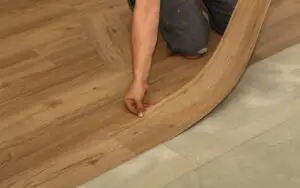The Allure of Polished Concrete Floors
Why Polished Concrete Floors Are Popular
Polished concrete floors have surged in popularity in recent years, becoming a sought-after choice for both residential and commercial spaces. Their sleek, modern aesthetic adds a touch of sophistication to any environment, while their durability and low maintenance requirements offer practical benefits. The appeal lies in their versatility, as they can be customized with various colors, stains, and finishes to complement any design scheme. However, achieving a truly professional-looking polished concrete floor requires a level of expertise and equipment that may not be readily available to the average homeowner.
Initial Costs vs. Long-Term Value
One of the initial draws of polished concrete floors is the perception of affordability. However, it’s crucial to consider the long-term value and potential hidden costs associated with DIY attempts. While the upfront investment may seem lower, the risk of errors, the need for specialized equipment, and the potential for costly repairs can quickly offset any initial savings. Professional services, while having a higher upfront cost, ensure a flawless finish, extend the lifespan of the floor, and ultimately provide a better return on investment.
Cheapest DIY Methods: A Deep Dive
DIY Polishing Kits: What You Need to Know
DIY polishing kits offer a tempting solution for homeowners looking to save money. These kits typically include a polishing compound, pads, and instructions. While they may seem straightforward, achieving a professional-grade finish with these kits is challenging. The quality of the materials is often subpar, and the lack of professional-grade equipment can lead to uneven polishing and unsatisfactory results. Furthermore, without proper training, it’s easy to damage the concrete surface, leading to costly repairs.
Staining and Sealing as an Alternative
For those seeking a more budget-friendly approach, staining and sealing can provide an alternative to traditional polishing. This method involves applying a stain to the concrete surface to add color and character, followed by a sealant to protect the surface. While this can enhance the appearance of the floor, it doesn’t offer the same level of durability or shine as polished concrete. Additionally, the longevity of the stain and sealer depends heavily on the quality of the products used and the expertise of the applicator.
Acid Washing for a Basic Clean
Acid washing is another DIY method often touted as a cost-effective way to clean and prepare concrete floors for polishing. However, this method involves using harsh chemicals that can be dangerous if not handled properly. Moreover, acid washing can etch the concrete surface, creating an uneven texture that is difficult to polish. Without proper neutralization and rinsing, residual acid can continue to damage the concrete over time. For these reasons, acid washing should only be attempted by experienced professionals who understand the risks and have the necessary safety equipment.
Potential Pitfalls of DIY Concrete Polishing
Uneven Polishing and Swirl Marks
One of the most common issues with DIY concrete polishing is uneven polishing, resulting in swirl marks and an inconsistent finish. This often occurs due to the use of inadequate equipment or improper techniques. Achieving a uniform polish requires a multi-step process using progressively finer diamond polishing pads, as well as the expertise to recognize when each step is complete. Without this knowledge, it’s easy to over- or under-polish certain areas, leading to an unsightly and unprofessional appearance.
Damage to the Concrete Surface
Another significant risk of DIY concrete polishing is damage to the concrete surface. Using the wrong type of polishing pads, applying too much pressure, or failing to properly prepare the surface can all result in scratches, gouges, or even cracks. Repairing this type of damage can be costly and time-consuming, often requiring the expertise of a professional concrete repair specialist. In some cases, the damage may be irreparable, necessitating the replacement of the entire floor.
Health and Safety Concerns
DIY concrete polishing also poses several health and safety concerns. The process generates a significant amount of dust, which can be harmful to breathe. Without proper ventilation and respiratory protection, this dust can cause respiratory irritation and long-term health problems. Additionally, the chemicals used in some polishing compounds and sealers can be hazardous if not handled properly. It’s essential to wear appropriate protective gear, such as gloves, eye protection, and a respirator, and to follow all safety instructions provided by the manufacturer.
Cost Breakdown: DIY vs. Professional
Material Costs for DIY
The material costs for DIY concrete polishing can vary depending on the size of the floor and the type of products used. A basic DIY polishing kit may cost several hundred dollars, while the cost of stains, sealers, and other supplies can add significantly to the overall expense. However, it’s important to remember that the quality of these materials is often lower than that of professional-grade products, which can impact the longevity and appearance of the finished floor.
Equipment Rental Fees
In addition to the cost of materials, DIY concrete polishing often requires the rental of specialized equipment, such as a concrete grinder or polisher. These machines can be expensive to rent, and the rental fees can quickly add up, especially if the project takes longer than expected. Furthermore, operating this equipment requires skill and experience, and improper use can result in damage to the floor or injury to the operator.
Time Investment and Labor Costs
DIY concrete polishing is a labor-intensive process that can take several days or even weeks to complete, depending on the size of the floor and the level of experience of the DIYer. The time investment involved can be significant, especially for those who have limited free time. Additionally, the physical demands of the job can be strenuous, requiring prolonged periods of standing, bending, and lifting. When factoring in the value of your time and the potential for injuries, the true cost of DIY concrete polishing can be much higher than it initially appears.
Professional Concrete Polishing: Why It’s Worth the Investment
Superior Equipment and Techniques
Professional concrete polishing services utilize state-of-the-art equipment and advanced techniques to achieve a flawless, long-lasting finish. They have access to high-quality diamond polishing pads, powerful grinders, and specialized sealers that are not typically available to DIYers. Furthermore, they have the expertise to select the right equipment and techniques for each specific project, ensuring optimal results.
Expertise in Concrete Assessment and Preparation
One of the key benefits of hiring a professional concrete polishing service is their expertise in concrete assessment and preparation. They can accurately assess the condition of the concrete floor, identify any potential problems, and develop a customized plan to address them. This may involve repairing cracks, filling holes, leveling the surface, or applying a concrete overlay to create a smooth, uniform base for polishing.
Long-Term Cost Savings and Durability
While professional concrete polishing may have a higher upfront cost than DIY methods, it offers significant long-term cost savings and durability. A professionally polished concrete floor is much more resistant to wear and tear, staining, and damage than a DIY floor. This means it will require less maintenance and fewer repairs over its lifespan, resulting in lower overall costs. Additionally, a professionally polished floor will retain its beauty and value for many years, making it a worthwhile investment in your property.
The Importance of Proper Concrete Preparation
Grinding and Leveling the Surface
Proper concrete preparation is essential for achieving a smooth, even, and professional-looking polished concrete floor. The first step in the preparation process is grinding the surface to remove any existing coatings, sealers, or imperfections. This is typically done using a heavy-duty concrete grinder equipped with diamond grinding pads. The grinding process also helps to level the surface, ensuring that there are no high or low spots that could affect the final finish.
Filling Cracks and Imperfections
Before polishing can begin, any cracks or imperfections in the concrete surface must be filled. This is typically done using a concrete patching compound or epoxy filler. The filler is applied to the cracks and imperfections, allowed to dry, and then sanded smooth to create a seamless surface. This step is crucial for preventing further damage to the concrete and for ensuring a uniform polish.
Ensuring a Smooth and Uniform Finish
The final step in the concrete preparation process is ensuring a smooth and uniform finish. This is typically done by using a series of progressively finer diamond polishing pads to further refine the surface. The goal is to create a surface that is free of scratches, swirls, and other imperfections. Once the surface is smooth and uniform, it is ready for polishing.
Sealing and Protecting Your Polished Concrete Floor
Choosing the Right Sealer
Sealing is a crucial step in protecting your polished concrete floor and ensuring its longevity. There are many different types of concrete sealers available, each with its own unique properties and benefits. Some sealers are designed to protect against staining, while others are designed to enhance the shine and durability of the floor. It’s important to choose a sealer that is appropriate for your specific needs and the type of concrete floor you have.
Application Techniques for Optimal Protection
The application of the sealer is just as important as the type of sealer you choose. The sealer should be applied evenly and thoroughly, following the manufacturer’s instructions carefully. It’s important to avoid applying too much sealer, as this can result in a cloudy or uneven finish. It’s also important to allow the sealer to dry completely before allowing traffic on the floor.
Maintaining the Seal for Long-Term Durability
Even with proper sealing, polished concrete floors require regular maintenance to ensure their long-term durability. This includes regular cleaning with a neutral pH cleaner and periodic re-sealing. The frequency of re-sealing will depend on the amount of traffic the floor receives and the type of sealer used. However, it’s generally recommended to re-seal polished concrete floors every 1-3 years.
Enhancing the Aesthetics: Staining and Dyeing Options
Selecting the Right Color and Stain
Staining and dyeing are excellent ways to enhance the aesthetics of your polished concrete floor and create a custom look. There are many different colors and stains available, ranging from subtle earth tones to bold, vibrant hues. The choice of color and stain will depend on your personal preferences and the overall design of your space. It’s important to choose a stain that is compatible with the type of concrete you have and the sealer you plan to use.
Application Methods for Uniform Color
The application of the stain or dye is crucial for achieving a uniform color and avoiding blotches or streaks. The stain should be applied evenly and thoroughly, following the manufacturer’s instructions carefully. It’s important to avoid applying too much stain, as this can result in a darker color than desired. It’s also important to allow the stain to dry completely before sealing the floor.
Achieving Custom Designs and Patterns
In addition to staining or dyeing the entire floor a single color, it’s also possible to create custom designs and patterns. This can be done using stencils, masking tape, or other creative techniques. The possibilities are endless, and with a little imagination, you can create a truly unique and personalized polished concrete floor. Professional installers can help you bring to life any design you have in mind.
Case Studies: DIY Disasters vs. Professional Success
Examples of Costly DIY Mistakes
There are countless examples of homeowners who have attempted to polish their concrete floors themselves and ended up with disastrous results. Some common mistakes include uneven polishing, swirl marks, scratches, and damage to the concrete surface. In many cases, these mistakes have been costly to repair, often requiring the expertise of a professional concrete repair specialist. In some cases, the damage has been so severe that the entire floor has had to be replaced.
Success Stories with Professional Polishing
On the other hand, there are many success stories of homeowners who have hired professional concrete polishing services and been thrilled with the results. These homeowners have enjoyed beautiful, durable, and low-maintenance polished concrete floors that have added value and style to their homes. They have also avoided the risks and headaches associated with DIY concrete polishing.
Analyzing the Return on Investment
When considering the cost of DIY vs. professional concrete polishing, it’s important to analyze the return on investment. While DIY may seem cheaper upfront, the potential for mistakes, the cost of equipment rental, and the time investment involved can quickly add up. Additionally, a professionally polished concrete floor will last longer and require less maintenance than a DIY floor, resulting in lower overall costs in the long run. In the end, investing in professional concrete polishing is often the most cost-effective and rewarding choice.
DIY vs. Professional Services: A Detailed Comparison
Quality of Finish and Longevity
The quality of finish and longevity are two key factors to consider when choosing between DIY and professional concrete polishing services. Professional services consistently deliver a higher quality finish due to their superior equipment, advanced techniques, and expertise in concrete assessment and preparation. This results in a smoother, more uniform surface with enhanced shine and durability. Furthermore, professionally polished concrete floors are more resistant to wear and tear, staining, and damage, ensuring they maintain their beauty and value for many years. DIY methods, on the other hand, often fall short in achieving the same level of quality and longevity due to the limitations of DIY equipment, lack of expertise, and potential for errors.
Risk of Damage and Liability
DIY concrete polishing carries a significant risk of damage to the concrete surface, as well as potential liability issues. Using the wrong type of equipment, applying too much pressure, or failing to properly prepare the surface can all result in scratches, gouges, cracks, or other damage that can be costly to repair. Additionally, DIY concrete polishing involves working with heavy machinery and potentially hazardous chemicals, which can increase the risk of personal injury. If someone is injured while working on a DIY concrete polishing project, the homeowner could be held liable. Professional concrete polishing services, on the other hand, have the experience, training, and insurance to mitigate these risks and protect homeowners from liability.
Overall Cost-Effectiveness
While DIY concrete polishing may seem cheaper upfront, it’s important to consider the overall cost-effectiveness in the long run. Professional concrete polishing services offer superior quality, longevity, and risk mitigation, which can result in significant cost savings over time. A professionally polished concrete floor will last longer, require less maintenance, and retain its value better than a DIY floor. Additionally, the cost of repairing DIY mistakes and the potential for liability issues can quickly offset any initial savings. In the end, investing in professional concrete polishing is often the most cost-effective and rewarding choice.
FAQs & Answers
Using a regular floor cleaner on polished concrete can be tempting for its convenience, but it often leads to a dull, lackluster surface over time. Many common household cleaners contain harsh chemicals that can strip away the sealant and damage the polished finish, making it more susceptible to stains and wear. Professional cleaning services use specially formulated, pH-neutral solutions that gently clean the surface without compromising its integrity. These specialized products not only preserve the shine but also help to extend the life of your polished concrete, ensuring it remains a beautiful and durable feature of your space. Therefore, while it may seem like a simple task, choosing the right cleaner is essential, and professional guidance can save you from costly damage.
On the surface, DIY concrete polishing might appear to be the more budget-friendly option, but a closer look reveals potential pitfalls that can lead to higher expenses in the long run. While you save on labor costs upfront, the price of renting professional-grade equipment, purchasing quality materials, and accounting for your time can quickly add up. Moreover, the learning curve for achieving a truly polished finish is steep, and mistakes can result in costly repairs or even the need to redo the entire project. Professionals, with their experience and specialized tools, can complete the job efficiently and effectively, minimizing the risk of errors and ensuring a durable, beautiful result. Therefore, while the initial investment may be higher, hiring a professional often proves to be the more cost-effective choice in the long term, protecting your investment and saving you from potential headaches.
Using acid to clean concrete floors is a practice fraught with risks, especially for those without professional training. While acid washing can remove stubborn stains and etches, it can also severely damage the concrete if not handled properly. The acid can weaken the concrete matrix, making it more prone to cracking and crumbling over time. Furthermore, improper neutralization of the acid can leave behind residues that continue to degrade the surface. Professional concrete cleaners are trained to assess the type of concrete and select the appropriate cleaning methods, often using safer alternatives or carefully controlled acid applications with thorough neutralization. Their expertise ensures the concrete is cleaned effectively without compromising its structural integrity, making it a safer and more reliable option.
The frequency of resealing a polished concrete floor is not a one-size-fits-all answer; it depends on several factors, including the amount of foot traffic, the type of sealer used, and the floor's exposure to spills and stains. In high-traffic areas, the sealant can wear down more quickly, requiring more frequent resealing to maintain its protective barrier. Neglecting to reseal can lead to the polished surface becoming vulnerable to damage from moisture, chemicals, and abrasion. Professional maintenance services can assess the condition of your floor and recommend the optimal resealing schedule based on its specific needs. Their expertise ensures that the resealing is done correctly, using high-quality products that will extend the life and beauty of your polished concrete floor.
While the initial appeal of DIY concrete floor polishing is the potential for cost savings, it's crucial to consider the long-term financial implications. DIY projects often lack the precision and expertise of professional services, leading to uneven finishes, surface damage, and a shorter lifespan for the polished floor. These issues can result in costly repairs or the need to redo the entire project, ultimately negating any initial savings. Professional polishing services, on the other hand, provide a durable, long-lasting finish that requires less maintenance and is more resistant to damage. Their expertise and high-quality materials ensure that your concrete floor remains in excellent condition for years to come, saving you money on repairs and replacements in the long run. Therefore, investing in professional polishing is often the more financially sound decision, providing a better return on investment and peace of mind.





